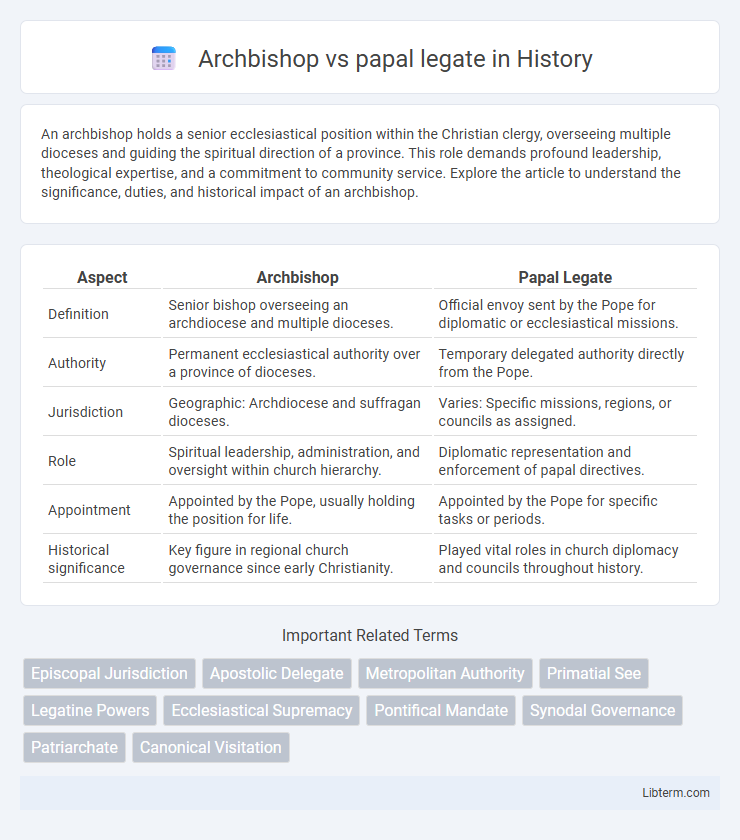An archbishop holds a senior ecclesiastical position within the Christian clergy, overseeing multiple dioceses and guiding the spiritual direction of a province. This role demands profound leadership, theological expertise, and a commitment to community service. Explore the article to understand the significance, duties, and historical impact of an archbishop.
Table of Comparison
| Aspect | Archbishop | Papal Legate |
|---|---|---|
| Definition | Senior bishop overseeing an archdiocese and multiple dioceses. | Official envoy sent by the Pope for diplomatic or ecclesiastical missions. |
| Authority | Permanent ecclesiastical authority over a province of dioceses. | Temporary delegated authority directly from the Pope. |
| Jurisdiction | Geographic: Archdiocese and suffragan dioceses. | Varies: Specific missions, regions, or councils as assigned. |
| Role | Spiritual leadership, administration, and oversight within church hierarchy. | Diplomatic representation and enforcement of papal directives. |
| Appointment | Appointed by the Pope, usually holding the position for life. | Appointed by the Pope for specific tasks or periods. |
| Historical significance | Key figure in regional church governance since early Christianity. | Played vital roles in church diplomacy and councils throughout history. |
Introduction: Understanding Church Hierarchies
An archbishop oversees an archdiocese, holding authority over bishops within that region and managing ecclesiastical governance. A papal legate serves as the pope's personal envoy, representing papal authority in diplomatic or church matters across varied territories. Both roles are integral to the hierarchical structure of the Catholic Church, facilitating governance and communication between the papacy and local churches.
Defining the Role of an Archbishop
An Archbishop is a senior bishop who presides over an archdiocese, providing spiritual leadership and administrative oversight to multiple dioceses within a province. Their role includes ordaining bishops, overseeing church doctrine adherence, and serving as a primary representative of the Church in significant regional matters. Unlike a papal legate, whose mission is temporary and directly appointed by the Pope for specific diplomatic or ecclesiastical tasks, an Archbishop maintains ongoing authority within their ecclesiastical jurisdiction.
What is a Papal Legate?
A papal legate is an official envoy or representative appointed by the Pope to act on his behalf in specific diplomatic or ecclesiastical matters. Unlike an archbishop who leads a particular archdiocese with jurisdiction over regional churches, a papal legate holds a temporary and often broader mandate to convey papal authority, oversee church councils, or negotiate with secular powers. This role emphasizes the legate's function as a direct extension of papal authority rather than a permanent diocesan leader.
Historical Origins of Archbishops and Papal Legates
Archbishops originated in the early Christian Church as senior bishops overseeing multiple dioceses, with roots tracing back to the Roman administrative system under Emperor Constantine. Papal legates emerged in the medieval period as official envoys appointed by the pope to represent papal authority in ecclesiastical and political matters, often during church councils or diplomatic missions. The distinct roles reflect the evolution of church hierarchy and papal influence from regional ecclesiastical governance to centralized papal jurisdiction.
Appointment Processes: Archbishop vs Papal Legate
The appointment of an archbishop is typically conducted through a formal ecclesiastical process involving the local synod, recommendations by bishops, and final approval by the Pope, highlighting the hierarchical nature of church governance. In contrast, a papal legate is directly appointed by the Pope as a special envoy, often for specific diplomatic or administrative missions, emphasizing the legate's role as a personal representative of papal authority. This distinction underscores the archbishop's ongoing territorial jurisdiction versus the papal legate's temporary and mission-specific mandate.
Jurisdiction and Authority Explained
An archbishop holds ecclesiastical authority within a specific province, overseeing multiple dioceses and guiding bishops under canonical law. A papal legate, appointed directly by the pope, exercises delegated authority that can surpass regional boundaries, acting as the pope's representative with mandates that vary from diplomatic to administrative jurisdiction. While archbishops operate within established hierarchical structures, papal legates possess temporary or special jurisdiction granted for specific missions, often involving broader or extraterritorial ecclesial authority.
Key Responsibilities and Duties Compared
Archbishops oversee the spiritual and administrative needs of an archdiocese, managing clergy, guiding doctrine, and representing the Church in regional matters. Papal legates act as direct envoys of the Pope, tasked with diplomatic missions, conveying papal directives, and often presiding over councils or negotiations on behalf of the Holy See. While archbishops maintain continuous pastoral leadership, papal legates serve temporary, mission-specific roles with authority delegated specifically by the Pope.
Influence within Church Governance
Archbishops hold significant authority over their archdioceses, overseeing multiple dioceses and playing a key role in regional Church governance and administration. Papal legates act as direct representatives of the Pope, wielding temporary but extensive influence during specific missions or councils, with authority often surpassing that of local bishops and archbishops. The distinction lies in the archbishop's permanent jurisdiction versus the papal legate's delegated, mission-specific power within Church hierarchy.
Notable Historical Examples
Archbishops and papal legates played distinct roles in church history, with notable figures highlighting their differences. Saint Thomas Becket, as Archbishop of Canterbury, famously resisted royal interference in church matters, asserting ecclesiastical authority. In contrast, papal legates like Cardinal Otto of Tonengo wielded papal power as direct representatives, enforcing Vatican policies across nations during the 13th century.
Conclusion: Archbishop vs Papal Legate—Key Differences
An archbishop is a senior bishop overseeing an archdiocese and possesses ecclesiastical authority within a specific region, while a papal legate acts as the pope's diplomatic representative with delegated powers to handle church affairs globally or in designated missions. The archbishop's role is primarily administrative and pastoral, rooted in local church governance, whereas the papal legate functions as an envoy of the Holy See, often involved in diplomatic negotiations and high-level church directives. Understanding these distinctions clarifies their unique functions in church hierarchy and governance.
Archbishop Infographic

 libterm.com
libterm.com